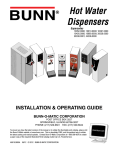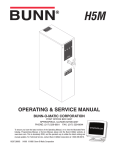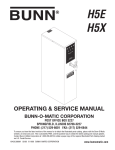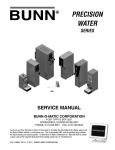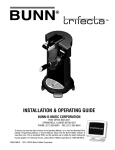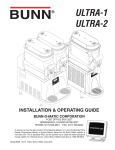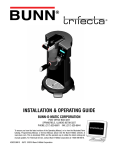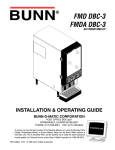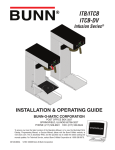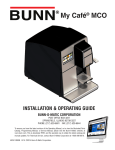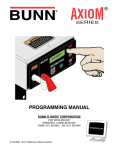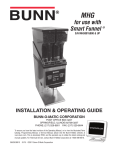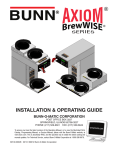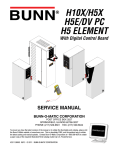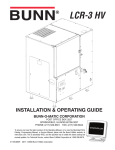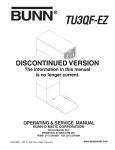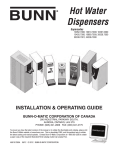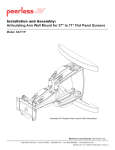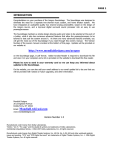Download OPERATING & SERVICE MANUAL
Transcript
H10X G IN RN ter WA Wa e! t ar o H ry h C Ve Wit e Us ! OPERATING & SERVICE MANUAL BUNN-O-MATIC CORPORATION POST OFFICE BOX 3227 SPRINGFIELD, ILLINOIS 62708-3227 PHONE: (217) 529-6601 FAX: (217) 529-6644 To ensure you have the latest revision of the manual or to obtain the illustrated parts catalog, please visit the Bunn-O-Matic website, at www.bunn.com. This is absolutely FREE, and the quickest way to obtain the latest catalog and manual updates. Contact Bunn-O-Matic Corporation at 1-800-286-6070 to obtain a paper copy of the required Illustrated Parts Catalog mailed via U.S. Postal Service. 10889.0000E 02/08 ©1995 Bunn-O-Matic Corporation www.bunn.com BUNN-O-MATIC COMMERCIAL PRODUCT WARRANTY Bunn-O-Matic Corp. (“BUNN”) warrants equipment manufactured by it as follows: 1) All equipment other than as specified below: 2 years parts and 1 year labor. 2) Electronic circuit and/or control boards: parts and labor for 3 years. 3) Compressors on refrigeration equipment: 5 years parts and 1 year labor. 4) Grinding burrs on coffee grinding equipment to grind coffee to meet original factory screen sieve analysis: parts and labor for 3 years or 30,000 pounds of coffee, whichever comes first. These warranty periods run from the date of installation BUNN warrants that the equipment manufactured by it will be commercially free of defects in material and workmanship existing at the time of manufacture and appearing within the applicable warranty period. This warranty does not apply to any equipment, component or part that was not manufactured by BUNN or that, in BUNN’s judgment, has been affected by misuse, neglect, alteration, improper installation or operation, improper maintenance or repair, damage or casualty. This warranty is conditioned on the Buyer 1) giving BUNN prompt notice of any claim to be made under this warranty by telephone at (217) 529-6601 or by writing to Post Office Box 3227, Springfield, Illinois 62708-3227; 2) if requested by BUNN, shipping the defective equipment prepaid to an authorized BUNN service location; and 3) receiving prior authorization from BUNN that the defective equipment is under warranty. THE FOREGOING WARRANTY IS EXCLUSIVE AND IS IN LIEU OF ANY OTHER WARRANTY, WRITTEN OR ORAL, EXPRESS OR IMPLIED, INCLUDING, BUT NOT LIMITED TO, ANY IMPLIED WARRANTY OF EITHER MERCHANTABILITY OR FITNESS FOR A PARTICULAR PURPOSE. The agents, dealers or employees of BUNN are not authorized to make modifications to this warranty or to make additional warranties that are binding on BUNN. Accordingly, statements by such individuals, whether oral or written, do not constitute warranties and should not be relied upon. If BUNN determines in its sole discretion that the equipment does not conform to the warranty, BUNN, at its exclusive option while the equipment is under warranty, shall either 1) provide at no charge replacement parts and/or labor (during the applicable parts and labor warranty periods specified above) to repair the defective components, provided that this repair is done by a BUNN Authorized Service Representative; or 2) shall replace the equipment or refund the purchase price for the equipment. THE BUYER’S REMEDY AGAINST BUNN FOR THE BREACH OF ANY OBLIGATION ARISING OUT OF THE SALE OF THIS EQUIPMENT, WHETHER DERIVED FROM WARRANTY OR OTHERWISE, SHALL BE LIMITED, AT BUNN’S SOLE OPTION AS SPECIFIED HEREIN, TO REPAIR, REPLACEMENT OR REFUND. In no event shall BUNN be liable for any other damage or loss, including, but not limited to, lost profits, lost sales, loss of use of equipment, claims of Buyer’s customers, cost of capital, cost of down time, cost of substitute equipment, facilities or services, or any other special, incidental or consequential damages. BrewWISE, BUNN Gourmet Ice, BUNN Pour-O-Matic, BUNN, Bunn-OMatic, Bunn-O-Matic, BUNNlink, BUNNserve, BUNN Espress, DBC, Dr. Brew, Dual, EasyClear, EasyGard, Easy Pour, FlavorGard, Gourmet Ice, Gourmet Juice, High Intensity, IMIX, Infusion Series, Legendary for Quality, The Mark of Quality in Beverage Equipment Worldwide, My Café, PowerLogic, Safety-Fresh, Scale-Pro, Single, Smart Funnel, Smart Hopper, Soft Heat, SplashGard, System III, ThermoFresh, 392, AXIOM, Beverage Profit Calculator, Beverage Bar Creator, BrewLOGIC, BrewMETER, BrewWIZARD, BUNNSERVE, BUNNsource, Coffee At Its Best, Cool Froth, Digital Brewer Control, Intellisteam, Nothing Brews Like a BUNN, Pouring Profits, Pulse Wave, Quality Beverage Equipment Worldwide, Signature Series, Silver Series, Smart Heat, SmartWAVE, Tea At Its Best, The Horizontal Red Line, Titan, Ultra, are either trademarks or registered trademarks of Bunn-O-Matic Corporation. 2 10889 020608 USER NOTICES Carefully read and follow all notices on the equipment and in this manual. They were written for your protection. All notices are to be kept in good condition. Replace any unreadable or damaged labels. ! WARNING Fill water tank before turning - on thermostat or connecting appliance to power source. Use only on a properly protected circuit capable of the rated load. Electrically ground the chassis. Follow national/local electrical codes. Do not use near combustibles. FAILURE TO COMPLY RISKS EQUIPMENT DAMAGE, FIRE, OR SHOCK HAZARD 12593.0000 This equipment must be installed to comply with the International Plumbing Code of the International Code Council and the Food Code Manual of the Food and Drug Administration (FDA). For models installed outside the U.S.A., comply with the applicable Plumbing /Sanitation Code. READ THE ENTIRE OPERATING MANUAL BEFORE BUYING OR USING THIS PRODUCT THIS APPLIANCE IS HEATED WHENEVER CONNECTED TO A POWER SOURCE 00831.0000F 3/98 ©1998 BUNN-O-MATIC CORPORATION 00831.0000 00656.0000 37881.0000 12537.0000 3 10889 021408 ELECTRICAL REQUIREMENTS CAUTION - The dispenser must be disconnected from the power source until specified in Initial Set-Up. This dispenser requires 2-wire, grounded service rated 208 or 240 volts ac, 40 amp, single phase. (Refer to the dispenser’s dataplate for exact voltage requirement.) Electrical Hook-Up CAUTION – Improper electrical installation will damage electronic components. 1. An electrician must provide electrical service as specified. 2. Using a voltmeter, check the voltage and color coding of each conductor at the electrical source. 3. Remove the side panel. 4. Install the proper electrical wiring to the terminal block. 5. Connect the dispenser to the power source and verify the voltage at the terminal block before proceeding. Reinstall the side panel. 6. If plumbing is to be hooked-up later be sure the dispenser is disconnected from the power source. If Plumbing has been hooked-up, the dispenser is ready for Initial Set-Up. PLUMBING REQUIREMENTS This dispenser must be connected to a cold water system with operating pressure between 20 and 90 psi (138 and 620 kPa) from a 1⁄2" or larger supply line. A shut-off valve should be installed in the line before the dispenser. Install a regulator in the line when pressure is greater than 90 psi (620 kPa) to reduce it to 50 psi (345 kPa). The water inlet fitting is 1⁄4" flare. NOTE - Bunn-O-Matic recommends 1⁄4" tubing for installations of less than 25 feet and 3/8" for more than 25 feet from the 1⁄2" water supply line. At least 18 inches of an FDA approved flexible beverage tubing, such as reinforced braided polyethylene or silicone, before the dispenser will facilitate movement to clean the countertop. Bunn-O-Matic does not recommend the use of a saddle valve to install the dispenser. The size and shape of the hole made in the supply line by this type of device may restrict water flow. This equipment must be installed to comply with the International Plumbing Code of the International Code Council and the Food Code Manual of the Food and Drug Administration (FDA). For models installed outside the U.S.A., you must comply with the applicable Plumbing/Sanitation Code for your area. Plumbing Hook-Up 1. Flush the water line and securely attach it to the flare fitting at the rear of the dispenser. 2. Turn on the water supply. 4 10889 021408 CE REQUIREMENTS • This appliance must be installed in locations where it can be overseen by trained personnel. • For proper operation, this appliance must be installed where the temperature is between 0°C to 35°C. • Appliance shall not be tilted more than 10° for safe operation. • An electrician must provide electrical service as specified in conformance with all local and national codes • This appliance must not be cleaned by water jet. • This appliance is not intended for use by persons (including children) with reduced physical, sensory or mental capabilities, or lack of experience and knowledge, unless they have been given instructions concerning use of this appliance by a person responsible for its safety. • If the power cord is ever damaged, it must be replaced by the manufacturer or authorized service personel with a special cord available from the manufacturer or its authorized service personel in order to avoid a hazard. INITIAL SET-UP CAUTION - The dispenser must be disconnected from the power source throughout the initial set-up, except when specified in the instructions. 1. Connect the dispenser to the power source and turn on the water supply. 2. The “HEATER” LED will glow for approximately five seconds. During this time, the electronic circuitry will check for a full tank of water. 3. If the tank is not full of water, the refill circuit will energize, indicated by the “REFILL” LED glowing. Water will automatically flow into the tank to the proper level and then shut off. 4. When the tank is full of water, the heater circuit will energize, indicated by the “HEATER” LED glowing intermittently until the proper temperature is achieved. A completely cold tank will take approximately twenty minutes for the water to heat. 5. The “READY” LED will glow when the proper water temperature is achieved. NOTE - Stop dispensing if the “READY” LED is off. Dispense only when the ”READY” LED glows. DRAINING THE DISPENSER CAUTION - The dispenser must be disconnected from the power source throughout these steps. 1. Disconnect the dispenser from the power source. 2. Shut-off and disconnect the incoming water supply 3. Remove the small screws from the sides and front of the top panel. 4. Gently remove one of the grommets from the tank lid. 5. Insert a tube to the bottom of the tank and syphon ALL of the water out. NOTE - The dispenser must be refilled using the INITIAL SET-UP steps before reconnecting to the power source. CLEANING The use of a damp cloth rinsed in any mild, non-abrasive, liquid detergent is recommended for cleaning all surfaces on Bunn-O-Matic equipment. 5 10889 021408 TROUBLESHOOTING A troubleshooting guide is provided to suggest probable causes and remedies for the most likely problems encountered. If the problem remains after exhausting the troubleshooting steps, contact the Bunn-O-Matic Technical Service Department. • Inspection, testing, and repair of electrical equipment should be performed only by qualified service personnel. • All electronic components have 200-240 volt ac and low voltage dc potential on their terminals. Shorting of terminals or the application of external voltages may result in board failure. • Intermittent operation of electronic circuit boards is unlikely. Board failure will normally be permanent. If an intermittent condition is encountered, the cause will likely be a switch contact or a loose connection at a terminal or crimp. • Solenoid removal requires interrupting the water supply to the valve. Damage may result if solenoids are energized for more than ten minutes without a supply of water. • The use of two wrenches is recommended whenever plumbing fittings are tightened or loosened. This will help to avoid twists and kinks in the tubing. • Make certain that all plumbing connections are sealed and electrical connections tight and isolated. • This dispenser is heated at all times. Keep away from combustibles. WARNING • Exercise extreme caution when servicing electrical equipment. • Disconnect the dispenser from the power source when servicing, except when electrical tests are specified. • Follow recommended service procedures. • Replace all protective shields or safety notices. PROBLEM PROBABLE CAUSE REMEDY Equipment will not operate. 1. No power or incorrect voltage (A) Check the terminal block for the correct voltage. It should be 200 to 240 volts ac across the red and black terminals for 200 to 240 volt models. (B) Check circuit breakers or fuses. 2. Overflow protection switch 6 Refer to Service - Overflow protection switch for testing procedures. See page 16. 10889 091599 TROUBLESHOOTING (cont.) PROBLEM PROBABLE CAUSE Automatic refill will not operate after 1. No water drawing hot water. REMEDY Check plumbing and shut-off valves. 2. Water strainer/flow control (A) Direction of flow arrow must be pointing towards dispenser. (B) Remove the strainer/flow control and check for obstructions. Clear or replace. 3. Overflow protection switch Refer to Service - Overflow protection switch for testing procedures. See page 16. 4. Liquid level system Refer to Service - Electronic controls for testing procedures. See page 11. 5. Solenoid valve Refer to Service - Solenoid valve for testing procedures. See page 17. 1. Solenoid valve Refer to Service - Solenoid valve for testing procedures. See page 17. Water flows into the tank continu- 1. Liquid level system ously. (Dispenser disconnected from power source). Refer to Service - Electronic controls for testing procedures. See page 11. Water flows into the tank con- 1. Overflow protection switch tinuously (Dispenser connected to power source). Refer to Service - Overflow protection switch for testing procedures. See page 16. Water is cold. Refer to Service - Limit thermostat for testing procedures. See page 15. 2. Limit thermostat CAUTION - Do not eliminate or bypass limit thermostat. Use only B.O.M. replacement part #23717.0003. 7 10889 101807 TROUBLESHOOTING (cont.) PROBLEM PROBABLE CAUSE REMEDY Water is cold (cont.) 3. Tank heater Refer to Service - Tank heater for testing procedures. See page 19. 4. Temperature control Refer to Service - Electronic controls for testing procedures. See page 12. 5. Dry plug protection Check connections to Interlock board and sheath of tank temperature probe. 1. Temperature control Refer to Service - Electronic controls for testing procedures. See page 12. 2. Lime build-up Inspect the tank assembly for excess lime deposits. Delime as required. Water boils continuously. CAUTION - Tanks and tank components should be delimed regularly depending on local water conditions. Excessive mineral build-up on stainless steel surfaces can initiate corrosive reactions resulting in serious leaks. Dispenser is making unusual nois- 1. Solenoid valve es. The nut on top of the solenoid valve must be tight or it will vibrate during operation. 2. Plumbing lines Plumbing lines should not be resting on the counter top. 3. Water supply (A) the dispenser must be connected to a cold water line. (B) Water pressure to the dispenser must not be higher than 90 psi. Install a regulator if necessary to lower the working pressure to approximately 50 psi. Ready indicator will not light. (when 1. Temperature control temperature is within 4˚ of its selected setting.) 2. Ready Indicator LED 8 Refer to Service - Electronic controls for testing procedures. See page 12. Replace the indicator LED. 10889 072700 SERVICE This section provides procedures for testing and replacing various major components used in this dispenser should service become necessary. Refer to Troubleshooting for assistance in determining the cause of any problem. Component Access WARNING - Disconnect the dispenser from the power source before the removal of any panel or the replacement of any component. P878 The limit thermostat, liquid level probe, tank heater, and temperature sensor are located at the top of the dispenser. Access is gained by removing the top lid, attached with four 4-40 slotted-head screws. WARNING - Inspection, testing, and repair of electrical equipment should be performed only by qualified service personnel. Disconnect the dispenser fromthe power source when servicing, except when electrical tests are required and the test procedure specifically states to connect the dispenser to the power source. P878 Electronic Controls....................................... 10-14 Limit Thermostat................................................15 Safety Overflow Switch......................................16 Solenoid Valve...................................................17 Tank Heater........................................................19 Electrical Schematic...........................................20 @ The check valve, electronic control assembly, overflow protection switch, solenoid valve, overflow tube temperature sensor, triac assembly and terminal block are located on the side of the dispenser. Access is gained by removing the side panel. The panel is attached with eight 8-32 slotted-head screws. 9 10889 091599 SERVICE (cont.) • • • • • Electronic Control Assembly Troubleshooting: Check these items first Is circuit board popped out of bracket? Is circuit board wet due to misaligned overflow tube? Is water in overflow cup activating float switch? Is overflow cup not making good contact with tank? Is dispenser being operated with panels removed? Triac Assy Electronic Control P1991 FIG. 1 ELECTRONIC CONTROL AND TRIAC Location: The electronic control assembly is located inside the side of the dispenser. Access will also be needed to the temperature sensor, overflow tube temperature sensor, and liquid level probe located on the tank lid and to the triac assembly located on the inside of the rear wall. General: This system controls the liquid level and water temperature of the dispenser. These two functions act independently of each other and should be tested separately. 10 10889 101807 SERVICE (cont.) 9. Check the voltage across the terminals 1 & 4 of the electronic control assembly with a voltmeter. Connect the dispenser to the power source. The indication must be 200 to 240 volts ac for 200 to 240 volt models after a delay of approximately 5 seconds. 10.Touch the screw head end of the probe to the dispenser housing. The indication must be 0. 11. Move the probe away from the dispenser housing. The indication must again be 200 to 240 volts ac for 200 to 240 volt models after a delay of approximately 5 seconds. 12.Disconnect the dispenser from the power source. Electronic Controls (cont.) Liquid Level Control Test Procedure 1. Disconnect the dispenser from the power source. 2. Check the voltage across terminals 3 & 4 of the electronic control assembly with a voltmeter. Connect the dispenser to the power source. The indication must be 200 to 240 volts ac for 200 to 240 volt models. 3. Disconnect the dispenser from the power source. If voltage was present as described, proceed to #4. If voltage was not present as described, refer to the Wiring Diagrams and check the dispenser wiring harness. 4. Remove the pink wire from terminal 5 of the electronic control assembly. 5. Check the voltage across terminals 1 & 4 of the electronic control assembly with a voltmeter. Connect the dispenser to the power source. The indication must be 200 to 240 volts ac for 200 to 240 volt models after a delay of approximately 5 seconds. 6. Disconnect the dispenser from the power source. If voltage was present as described, reinstall the probe, the sensing function of the system is operating properly. If voltage was not present as described, check the pink probe wire and the green ground wire for continuity and/or replace the probe. Temperature control Flow Charts If voltage was present as described, the liquid level control of the system is operating properly, proceed to #7. If voltage was not present as described, replace the electronic control assembly and the temperature sensor in the tank lid. NOTE - Each electronic control assembly is calibrated to a temperature sensor. Both components MUST be replaced as a set. 7. Reconnect the pink wire to terminal 5 of the electronic control assembly. 8. Loosen the compression fitting, remove the probe from the tank lid, and inspect it for mineral deposits. Replace it if necessary. Keep the exposed ends of the probe away from any metal surface of the dispenser. 11 10889 091599 SERVICE (cont.) Electronic Controls (cont.) If the indicator was on or blinking, the temperature sensor is operating properly, proceed to #7. If the indicator was off, check the sensor connection on the electronic control circuit board and/or replace the temperature sensor and the electronic control assembly. Temperature Control Flow Charts (cont.) NOTE - Each temperature sensor is calibrated to an electronic control assembly. Both components MUST be replaced as a set. 7. Check the voltage across the tank heater terminals with a voltmeter. Connect the dispenser to the power source. The indication must be 200 to 240 volts ac for 200 to 240 volt models while the red indicator on the circuit board is on or blinking. 8. Disconnect the dispenser from the power source. If voltage was present as described, the temperature control of the system is operating properly. If voltage was not present as described, contact Bunn-O-Matic to order an electronic control assembly temperature sensor, and triac assembly for evaluation and proceed to #9. Temperature Control Test Procedure 1. Disconnect the dispenser from the power source. 2. Check the voltage across terminals 3 & 4 of the electronic control circuit board with a voltmeter. Connect the dispenser to the power source. The indication must be 200 to 240 volts ac for 200 to 240 volt models. 3. Disconnect the dispenser from the power source. 9. Replace the electronic control assembly and temperature sensor. NOTE - Each electronic control assembly is calibrated to a temperature sensor. Both components MUST be replaced as a set. 10.Check the voltage across the tank heater terminals with a voltmeter. Connect the dispenser to the power source. The indication must be 200 to 240 volts ac for 200 to 240 volt models while the red indicator on the circuit board is on or blinking. If voltage was present as described, proceed to #4. If voltage was not present as described, refer to the Wiring Diagram and check the dispenser wiring harness. 4. Connect the dispenser to the power source . 5. Observe the red indicator on the electronic control circuit board. 6. Disconnect the dispenser from the power source. 12 10889 091599 SERVICE (cont.) 5. Install the new temperature sensor into the grommet on the tank lid. Route the wires to the location of the new electronic control assembly. 6. Attach the temperature sensor, overflow tube temperature sensor, and indicator wires to the electronic control assembly. 7. Fasten the new electronic control assembly to its bracket. 8. Reconnect the wires. 9. Review the initial set-up procedures. Electronic Controls (cont.) 11.Disconnect the dispenser from the power source. If voltage was present as described, return the new triac assembly to Bunn-O-Matic for credit. The temperature control of the system is operating properly. If voltage was not present as described, reinstall your existing electronic control assembly and temperature sensor, and proceed to #12 12.Replace the triac assembly. 13.Check the voltage across the tank heater terminals with a voltmeter. Connect the dispenser to the power source. The indication must be 200 to 240 volts ac for 200 to 240 volt models while the red indicator on the circuit board is on or blinking. 14.Disconnect the dispenser from the power source. BLU to Triac Assy TAN to Triac Assy BLU to Triac Assy TAN to Triac Assy PNK to Liquid Level Probe RED to Terminal block RED to Solenoid BLK to Overflow Safety Switch GRN to Chassis Ground WHI/BLU to Solenoid If voltage was present as described, the temperature control of the system is operating properly. Return the new electronic control assembly and temperature sensor to Bunn-O-matic for credit. FIG. 2 WIRING CONNECTIONS Electronic Control Removal and Replacement NOTE - Each electronic control assembly is calibrated to a temperature sensor probe. Both components MUST be replaced as a set. P1992 WHI & WHI to Temperature Sensor 1. Remove all wires from the electronic control assembly terminals. 2. Remove the two 8-32 screws holding the electronic control assembly to the component bracket. 3. Disconnect the temperature sensor, overflow tube temperature sensor, and indicator wires from the left side of the electronic control assembly board. 4. Remove the temperature sensor from the grommet in the tank lid. PNK & GRY to Heater Indicator Refill Indicator Power Indicator Ready Indicator GRY & GRY to Thermistor P1 P2 P101 P1992 FIG. 3 WIRING CONNECTIONS 13 10889 091599 SERVICE (cont.) 3. Securely fasten the new triac assembly to the rear panel in the same relative position as the one removed. Bunn-O-matic recommends tightening the nut to a torque setting of approximately 18 inch-pounds. 4. Disconnect the other ends of the old triac assembly wires. 5. Connect the TAN and BLU wires with spade terminals of the new assembly to the electronic control assembly, FIG. 2. 6. Connect the BLU wire with the ring terminal to the tank heater, FIG. 12. 7. Connect the WHI/VIO wire of the new assembly to the RED terminal at the terminal block. Electronic Controls (cont.) Triac Assembly Removal and Replacement NOTE - Each triac installation requires the use of an approved silicone heat sink compound. Bunn-O-Matic recommends the use of Dow Corning 340 compound or equivalent. It can be purchased direct from BunnO-Matic (P.N. M2522.1000) 1. Remove the existing triac assembly held in place with a 10-32 hex keps nut. 2. Apply a small amount of the silicone heat sink compound to the copper heat sink. 14 10889 091599 SERVICE (cont.) If voltage was present as described, reconnect the black wire and proceed to #5. If voltage was not present as described, refer to the Wiring Diagrams and check the dispenser wiring harness. Limit Thermostat Limit Thermostat Location: The limit thermostats are located on the tank lid. To test the limit thermostats, access will also be needed to the terminal block located on the side of the dispenser. 5. Check for continuity across the terminals of the limit thermostat. If continuity is not present as described, the circuit is broken. Press the reset button of the limit thermostat and recheck for continuity. If continuity is not present as described, replace the limit thermostat. FIG. 5 LIMIT THERMOSTAT Removal and Replacement: 1. Remove both wires from the limit thermostat terminals. 2. Remove the two #10-32 nuts attaching the limit thermostat to the top of the tank. 3. Install the new limit thermostat and secure into place with two #10-32 nuts. 4. Refer to FIG. 6 when reconnecting the wires. P1993 Test Procedure: 1. Disconnect the dispenser from the power source. 2. There are two black wires on the limit thermostat terminals. One comes from the terminal block. The other goes directly to the tank heater terminal. Remove the black wire at the limit thermostat coming from the terminal block. 3. Check the voltage across the black wire removed from the limit thermostat and the red wire of the terminal block with a voltmeter. Connect the dispenser to the power source. The indication must be 200 to 240 volts ac for 200 to 240 volt models. 4. Disconnect the dispenser from the power source. BLK to Terminal Block Reset BLK to Tank Heater P1776 FIG. 6 LIMIT THERMOSTAT WIRING 15 10889 091599 SERVICE (cont.) Removal and Replacement: 1. Disconnect the black wires from the overflow protection switch. 2. Remove the nut beneath the copper overflow cup. 3. Remove the entire switch assembly from the cup. 4. Place the new switch assembly into the cup, wires first. Make sure that a gasket is in place around the threaded switch stem. Overflow Protection Switch NOTE - The magnets must be at the top of the float and there must be NO stainless steel washers installed for the overflow protection switch to operate properly. 5. Install the nut beneath the copper overflow cup. Be sure not to overtighten. 6. Reconnect the wires, FIG. 8. P1993 FIG. 7 OVERFLOW PROTECTION SWITCH Location: The overflow protection switch is located within the side of the dispenser inside the copper overflow cup. For testing or removal of the overflow protection switch, access may also be needed by removing the two screws attaching the electronic control assembly to its mounting bracket. RED to BLK Wire from Terminal Block Test Procedure: 1. Once voltage is verified at the power source, check for continuity across the overflow protection switch red wires only until the plastic float is raised and check that continuity returns when the plastic float is again lowered. RED to BLK Wire from Electronic Control #3 P1777 FIG. 8 OVERFLOW PROTECTION WIRING If continuity is present as described, reconnect each of the red wires to the black wires, the overflow protection switch is operating properly. If continuity is not present as described, replace the overflow protection switch. 16 10889 091599 SERVICE (cont.) If voltage was present as described, proceed to #5. If voltage was not present as described, refer to the Wiring Diagrams and check the dispenser wiring harness. Solenoid Valve Location: The solenoid valve is located within the side of the dispenser on the right side near the bottom. To test the solenoid valve, access will also be needed to the electronic control assembly. 5. Remove both wires from the solenoid valve coil terminals. 6. Check for continuity across the solenoid valve coil terminals. If continuity is present as described, reconnect the wires and proceed to #7. If continuity is not present as described, replace the solenoid valve coil. WA R NIN 7. Check the solenoid valve for coil action. Connect the dispenser to the power source. Listen carefully in the vicinity of the solenoid valve for a “clicking” sound after approximately 5 seconds, as the coil magnet attracts the plunger. 8. Disconnect the dispenser from the power source. 9. Reconnect the pink wire to terminal 5 of the electronic control assembly. G HA ZA VO RDOU LT AG S DISC E PO ONNE BE WER CT FO FR RE SOUR OM RE MO CE VING ! If the sound was heard as described and water will not pass through the solenoid valve, there may be a blockage in the water line before or after the solenoid valve or the solenoid valve may require inspection for wear and removal of waterborne particles. If the sound was not heard as described, replace the solenoid valve. P1994 FIG. 9 SOLENOID VALVE Test Procedure: 1. Disconnect the dispenser from the power source and turn off the water supply to the dispenser. 2. Remove the pink wire from terminal 5 of the electronic control assembly. 3. Check the voltage across the solenoid valve coil terminals with a voltmeter. Connect the dispenser to the power source. The indication must be 200 to 240 volts ac for 200 to 240 volt models after a delay of approximately 5 seconds. 4. Disconnect the dispenser from the power source. Removal and Replacement: 1. Remove all wires from the solenoid valve coil. 2. Turn off the water supply to the dispenser. 3. Disconnect the water lines to and from the solenoid valve. 4. Remove the two 8-32 slotted-head screws holding the solenoid valve and mounting bracket to the component bracket. 17 10889 101807 SERVICE (cont.) Solenoid Valve (cont.) 5. Lift out the solenoid valve. 6. Remove the two 10-32 slotted-head screws holding the solenoid valve to its mounting bracket. 7. Securely install the new solenoid valve to its mounting bracket. The direction of flow arrow must be pointing towards the tank lid. 8. Attach the solenoid valve and mounting bracket to the component bracket. 9. Securely fasten the water lines to and from the solenoid valve. 10.Reconnect the wires, FIG. 10. WHI/BLU to Electronic Contol #1 RED to Terminal Block RED to Electronic Control #5 P1779 FIG. 10 SOLENOID VALVE WIRING 18 10889 091599 SERVICE (cont.) If voltage is present as described, proceed to #4. If voltage is not present as described, replace the tank heater. Tank Heater Location: 4. Remove the tank heater from the tank lid and inspect it for cracks in the sheath. The tank heater is located in the tank lid. If continuity is present as described, reinstall the tank heater. The tank heater is operating properly. If continuity is not present as described, replace the tank heater. FIG. 11 TANK HEATER Removal and Replacement: 1. Remove the wires to the tank heater. 2. Remove the 8-32 nuts from the tank heater flange. 3. Remove the tank heater. 4. Inspect the tank heater gasket and replace if necessary. 5. Securely install the new tank heater. Be certain of a watertight seal. 6. Reconnect the wires, FIG. 12. P1993 Test Procedure: 1. Disconnect the dispenser from the power source. 2. Check the voltage across the terminals of the tank heater with a voltmeter. Connect the dispenser to the power source. The indication must be 200 to 240 volts ac for 200 to 240 volt models. 3. Disconnect the dispenser from the power source. BLU to Triac Assy BLK to Limit Thermostat P1780 FIG. 12 TANK HEATER WIRING 19 10889 091599 WIRING DIAGRAM L1 BLK GRN/YEL L2 RED SCHEMATIC WIRING DIAGRAM H10XA BLK BLK TRIAC LIMIT THERMOSTAT BLK BLU WHI/VIO TANK HEATER BLK BLK LIMIT THERMOSTAT RED RED TRIAC BLU BLK OVERFLOW PROTECTION SWITCH RED MAIN ON/OFF SWITCH (Late Models only) WHI/VIO TANK HEATER BLK BLK HEATER WHI WHI PNK GRY GRY PNK PNK GRY PNK GRY REFILL POWER READY GRY GRY P1 9 8 ELECTRONIC 7 CONTROL 6 ASSY P2 5 4 3 2 1 PNK- 20 RED GRN/YEL WHI/BLU SOL J1 INTERLOCK (DRY PLUG-IN) ASSY J2 RED REFILL PROBE P101 J3 GRN/YEL WHI/RED BLU TAN BLU TAN RED WHI WHI TEMP. SENSOR GRY GRY t° STEAM SENSOR DRY LEVEL PROBE 200-240 VOLTS AC 2 WIRE + GND SINGLE PHASE 10888.0000C 01/07 © 1989 BUNN-O-MATIC CORPORATION 20 10889 101807




















